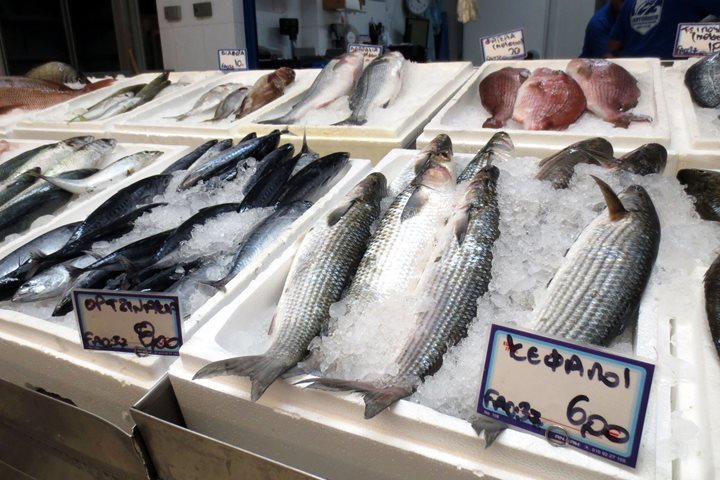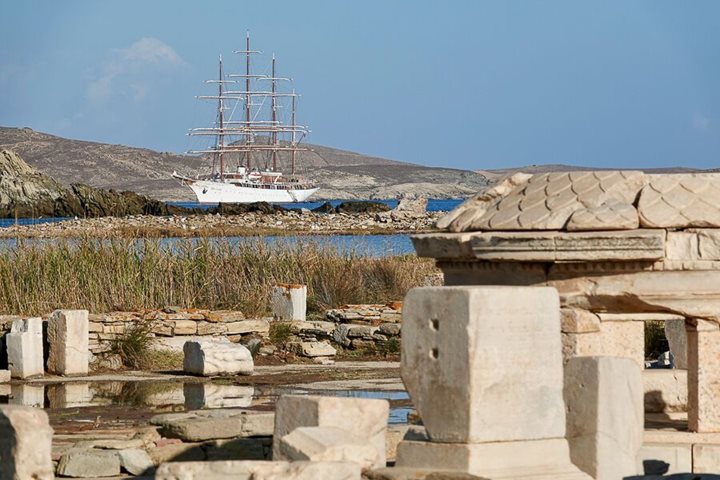Every guidebook or website of the “top islands in the world to visit” is sure to include the enormous volcanic caldera of Santorini in the top tier, and with good reason. Physically, its dramatic 900-foot cliffs of colorfully banded rock rising out of the clear aquamarine waters are jaw-dropping. Culturally, the whitewashed cubist-style labyrinthine architecture with emphatic blue-domed churches and colorful doors and windows are quintessentially Cycladic in their small island village enclaves. Never mind that they are perched spectacularly at the edges of cliffs hundreds of feet above the caldera below. Historically and archaeologically, the island was the home to one of the most advanced prehistoric civilizations known to us today, which disappeared with the cataclysmic eruption of the island in 1628 B.C. Agriculturally, the volcanic soils cultivate a variety of special vegetables like the round, white eggplant, the delicate but flavorful tiny tomatoes, the sweetest of the chickpeas or “fava” and of course the famous Santorini white wines. And of course the island is a mecca for high quality and sophisticated arts, crafts, jewelry, and clothing.
But nothing can prepare the visitor arriving by sea for the unfathomable magnitude and scale of this island group that is the remainder of that ancient eruption, or for the mental gymnastics of trying to imagine the size and extent of the eruption that wiped out a sophisticated civilization and caused a global cosmic winter for three years. Sailing into the caldera by ship and realizing that you are now inside the interior of the remnants of the volcano circling around you is almost too much for the imagination to process. Santorini merits its reputation.
Because Santorini deserves to be such a highlight experience, Captain Komakin and I plan the entire week’s itinerary first and foremost around how to make the most of our Santorini visit, especially avoiding the numerous large cruise ships that call at the main port with its overused donkey trails and cable cars. So we snuck in on Thursday night after the last cruise ship had departed, spent the night under the illuminated crystalline lighting of the towns on the rim high above, and departed in the quiet of an empty morning to maximize our time and experience at the jewel of Santorini; the north-end village of Oia (pronounced “ee-ya”). Sea Cloud repositioned during the course of the day while we enjoyed our time on the island visiting Oia, the Prehistory Museum, the mind-blowing excavation site of Akrotiri that had been buried by the layers of ash from the last eruption, and a wonderful local lunch featuring the Santorini specialties and hosted by local vintner Nektarios at his restaurant Kallisti.
A glorious surprise awaited us on our return to Sea Cloud, when we had the opportunity to swim in the caldera under the masts of the Sea Cloud next to the primeval basalt piles of the newly forming island volcano of Nea Kameni. And if that wasn’t enough, we had a deck dinner for our sunset cruise around the six-mile-wide caldera that finished with an enchanting sunset under the village of Oia where we had started our morning. A few of us who had been to Santorini before commented that “last time we were here, it certainly wasn’t like this.” Indeed, it was a day to remember for a lifetime, which is what this legendary island of Santorini deserves.







